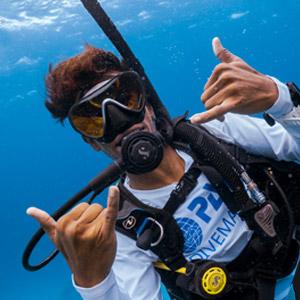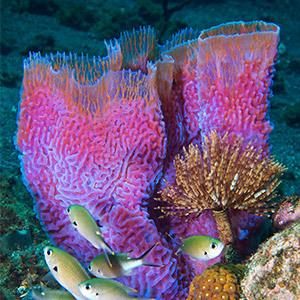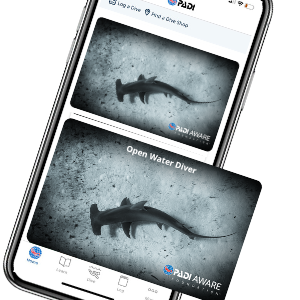So many ships went down off the coast of North Carolina throughout history that the Outer Banks earned the nickname “the Graveyard of the Atlantic.”
Today, the shipwrecks are far from dead. The waters around them bustle with divers and tiger sharks, while the hulls sway with anemones and coral. History flows through every porthole and runs through every beam, each wreck telling its silent story - many of them about WWII.
The region’s treacherous past leaves divers with scores of options to choose from when planning their next adventure. If diving a graveyard is on your bucket list but you can’t decide where to begin, consider any of these amazing Carolina time capsules:
1. U-352
Without a doubt, one of the biggest draws to the Outer Banks is the opportunity to dive on this historic World War II German U-boat. On May 9, 1942, the U-352 was cruising close to the North Carolina coast in search of enemy targets when she picked a fight with the wrong ship. The scrappy USCG Cutter Icarus was on her game that day when the U-352 opened fired with torpedoes and missed. In retaliation, the Icarus launched depth charges and sunk the U-352 in 110/30 meters feet of water, 28 nautical miles south of Morehead City. Thirteen men perished in the attack while 33 survivors were picked up by the Icarus and returned to Charleston, where they remained as prisoners of war for the remainder of WWII. Sitting with a 45-degree list to starboard and its conning tower intact, the U-352 fascinates divers and stokes their imagination when they get a glimpse of this amazing piece of history.
2. Papoose
The wreck of the Papoose has a convoluted history since, in actuality, it is the wreck of the W.E. Hutton. During the early stages of WWII, German U-boats wreaked havoc along the Eastern seaboard sinking numerous Allied merchant ships. In the confusion, the wreck of the W.E. Hutton was misidentified by the United States Navy and thought to be the wreck of the Papoose. Even though this was later clarified, most still refer to the ‘Hutton’ as the Papoose. Sitting upside down in 120 feet/37 meters of water, the 435-foot/133-meter tanker is a favorite to many. Divers come to see the plethora of marine life, which includes sand tiger sharks appearing with regularity. With the Papoose resting nearly 36 nautical miles from shore, its popularity is increased due to the clear waters of the Gulf Stream; 100 feet/30 meters of visibility is not unheard of on the Papoose aka the W.E. Hutton.
3. USCG Cutter Spar
Not all the wrecks of North Carolina met their end due to tragic events. The USCG Cutter Spar is one of the many wrecks sent to the bottom as part of the North Carolina artificial reef project. The 180-foot/55-meter buoy tender sits in 110 feet/34 meters of water with a strong list to port. It has become a very popular dive because it’s fully intact, easily navigable, and a favorite hangout for sand tiger sharks, schools of Atlantic spadefish, and the occasional giant southern stingray. Amazingly, the Spar was moved 200 feet/61 meters from her original location and rolled over on her port side when Hurricane Irene struck the coast in August 2011. She weathered the storm intact, though — a tough little ship.
4. USS Schurz
The captured World War I German gunship, the USS Schurz, is a classic North Carolina wreck dive. The 255-foot/78 meter ship sunk the night of June 21, 1918, 30 nautical miles south of Beaufort Inlet, after colliding with the SS Florid. When discovered in the 1980s, it was a popular dive for those seeking to reclaim artifacts and take home a small piece of history. Brass portholes, crew personal effects, and weapons were some of the many items removed. Today, it is illegal to take artifacts from the Schurz and most are content to see the beautiful reef system this wreck site has become. Colorful sea fans, abundant marine life, dense schools of baitfish, and the occasional shark keep divers returning year after year to this treasure trove of a dive site.
5. Caribsea
The wreck of the Caribsea is one of those hit and miss dive sites. Notorious for low visibility conditions as well as large schools of sand tiger sharks, this dive can be a top shelf experience when the blue water pushes in on rare days, exposing up to 100 sand tiger sharks in one spot. Sunk on March 11, 1942, by a German U-boat attack, this 251-foot/77 meter freighter sits in 90 feet/27 meters of water on the east side of Cape Lookout Shoals. Scientists believe the sand tiger sharks gather here during the summer months to mate.
6. Aeolus
The Aeolus is another one of North Carolina’s popular wrecks that was sunk as part of the artificial reef program and rests only a few hundred feet from the Spar. This 400-foot/122 meter wreck sits in 110 feet/33 meters of water and was split in two during a powerful hurricane that swept through the region in the 1990s. During the 2012 dive season, the Aeolus became home to approximately a dozen sand tiger sharks that took up residence inside the wreck. Divers returned day after day to swim right amongst the sharks in what became known as ‘Club Aeolus,’ North Carolina’s coolest shark lounge.
7. Proteous
No top ten list for North Carolina would be complete without including this luxe wreck. The 390-foot/199 meter luxury steam liner Proteous sunk on August 19, 1918, in a collision with the SS Cushing approximately 20 nautical miles south of Cape Hatteras. Mostly a low-lying debris field, with the exception of the prominent stern and propeller, she was popular dive for artifact hunters during the 80s and 90s. Today, it is a hot spot for shark sightings, vast numbers of grouper, and big pelagic life, such as African Pompano, giant amberjacks and barracudas. The clear warm Gulf Stream water that regularly sweeps through enhances this impressive dive.
8. Atlas
Another victim of a German U-boat attack, the 430-foot/131 meter Atlas tanker sank on April 9, 1942, only a few miles from the wreck of the Caribsea in 115 feet of water. Like the Caribsea, the visibility on the Atlas can sometimes be less than 20 feet/6 meters, but when the blue water rolls in this wreck site is a showstopper. Enormous sand tiger sharks at a whopping 10 feet/3 meters in length can be seen patrolling the wreck by the dozen. The marine life is thick on this wreck and an opportunity to dive it should not be missed.
9. USS Indra
The wreck of the USS Indra has many humorous aliases, such as the Indra Maru (after the famed Japanese wrecks of Truk Lagoon), or the Indra Doria (after the Mount Everest of wreck dives, the Andrea Doria). This 330-foot/101-meter landing craft was sunk in 60 feet/18 meters of water only 10 miles/16 kilometers from Beaufort Inlet as part of the North Carolina artificial reef program. Since the 1990s, it has been visited by more divers probably then any other wreck off the Outer Banks. Because the ship is partially intact, sitting upright and within close proximity to Morehead City, she attracts both novice and advanced divers alike. Whatever you call the ”Indra,” she is a legendary wreck site in her own right.
10. Naeco
On March 23, 1942, the 411-foot/125 meter Naeco went down in a fiery mess at the hands of yet another German U-boat attack during World War II. Today, the ship sits in two distinct pieces about one mile/1.6 kilometers apart some 38 nautical miles due south of Morehead City. This wreck, which sits in an average of 140 feet/43 meters, is as far offshore as dive boats will venture. With clear, warm Gulf Stream water being the standard conditions here, it appeals to those divers who don’t mind the deeper depths.
Start your wreck diving adventure today.

 Open Water Diver & Dive Against Debris eLearning Bundle
Open Water Diver & Dive Against Debris eLearning Bundle
 Advanced Open Water & Enriched Air eLearning Bundle
Advanced Open Water & Enriched Air eLearning Bundle
 Emergency First Response
Emergency First Response
 FREE – Introduction to Scuba Diving Online
FREE – Introduction to Scuba Diving Online






 Marine Debris
Marine Debris
 Shark & Ray Protection
Shark & Ray Protection
 Adopt The Blue
Adopt The Blue


















